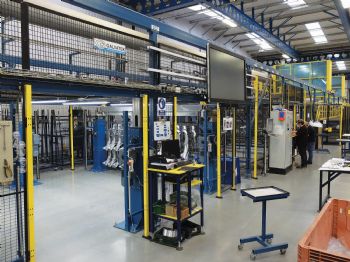
BCW Treatments Ltd is an aluminium anodising company that opened in early 2015 to provide a service to companies using the sub-contract machining services of BCW Manufacturing Group’s machine shops on the same Innovation Drive industrial estate.
Anodising is carried out using a Galvatek automated finishing line supplied by Turbex Ltd (
www.turbex.co.uk), which is based in Alton, Hampshire. This was considered to be the best all-round package of three alternatives considered, and currently an average of 2,600m2 of product are finished per week.
One of BCW’s automotive contracts involves producing aluminium components — mainly from A365 castings, 6060 extrusion, super-plastic 5083 and 5754 sheet — for a premium automotive customer in the UK that specialises in manufacturing ‘luxury sports cars and grand tourers’.
More recently, the company has received further business from another prestigious UK automotive customer — one that produces high-performance 4¥4s and special-operations vehicles.
The work will start at the end of 2018; it will entail the installation — in an adjacent factory — of a line for passivating components as a corrosion-resistant pre-treatment.
Enquiries have also been received for finishing lightweight components for aircraft (such as cabin seating), electric cars, hybrid cars, amphibious vehicles and lorries.
Andrew Wilson, managing director of BCW Treatments, said: “Although anodising is more than a century old, the latest process is an exacting discipline that requires extremely close control to achieve the highest quality and — even more importantly — the correct film properties.
“Some manufacturers’ car parts are adhesively joined rather than welded, and a nominal thickness of the anodic layer of between 2 and 10µm is required; above this, there is a risk of components pulling apart under stress.
“A tolerance band of 4-6µm is achieved in the Turbex line, so precise is the process.”
An enterprise resource planning (ERP) system drives the finishing process, raising each manufacturing order and triggering the issue of material.

The line’s control system ‘learns’ which aluminium products are mounted on which universal or part-specific jig by scanning the manufacturing order. Once it knows the part number, the correct program is automatically selected.
There are four load/unload stations at one end of the line, where components are loaded onto ‘flight bars’ that progress to a buffer station; they are then picked up by one of two overhead transporters and dipped into 15 tanks sequentially. Up to five jobs can be processed simultaneously in the line.
Automatic dosing stations are provided for the metered dosing of chemicals into several of the tanks, the quantity being worked out automatically according to the amount of surface area to be anodised on each flight bar.
The working environment is ‘clean and fume-free’, as each tank is hermetically sealed, and the lid is not opened until a transporter is directly above it; positive pressure pulls the fumes through the handling system to a ‘scrubbing’ unit.
After the anodising process has been completed, flight bars are returned to four load/unload stations adjacent to the loading area, and test pieces are taken away for analysis (this includes pull and shear tests after adhesive has been applied).
Following each successful test, the ERP system is advised that the components are ready for delivery to the customer.
The anodising sequence
Because a conveyor is not involved in transporting flight bars around the system, the anodising process starts in the centre of the line and initially progresses away from the load/unload stations.
Alkaline degreasing takes place in the first tank (this can take up to 1hr for the most soiled castings), followed by rinsing off in ‘town’ water in the next two tanks, the water being recycled between the second and third stage.
Tank 4 is a chemical etch that uses using sodium hydroxide to remove pre-existing aluminium oxide from the surface of components.
The immersion time is controlled to avoid unduly changing the geometry of the components; this immersion also precludes the need to plug holes, saving costs and eliminating the risk of parts being returned by the customer if plugs have been inadvertently left in.
An ‘eco-rinse cycle’ in town water is performed in the next three tanks, again with recycling between the stages. The following process, which takes place at the far end of the line in tank 8, is the removal — in a mix of nitric acid and hydrofluoric acid — of alloying elements on the surface of components — especially castings — that remain after chemical etching.

Two further eco-rinse immersions in tanks 9 and 10 bring the pre-treatment to a close, by which time the components have travelled back past the centre tank towards the load/unload stations.
The actual anodising stage of the process is in tank 11, which contains sulphuric acid; it lasts 8-10min, during which time a nominal 4-6µm-thick film is deposited.
A feature of this part of the process is continuous dosing of the acid, instead of recycling the fluid when the aluminium content reaches — say — 20gm per litre. Waste is avoided by using a pump to recirculate the fluid through a ‘retardation’ unit that filters the aluminium out.
A clean rinse in three successive tanks containing de-ionised water — produced locally within the line — ends with an ultra-clean rinse to ensure that conductivity is less than 200µS (micro-siemens).
The last stage, prior to the flight bar being taken back to the unload station, is hydrothermal sealing at 96°C in a proprietary chemical blend.
Reserved for high-end applications and involving 30µm particulate filtration, this process seals microscopically small pores created on the surface of components as a result of dielectric breakdown during anodising.